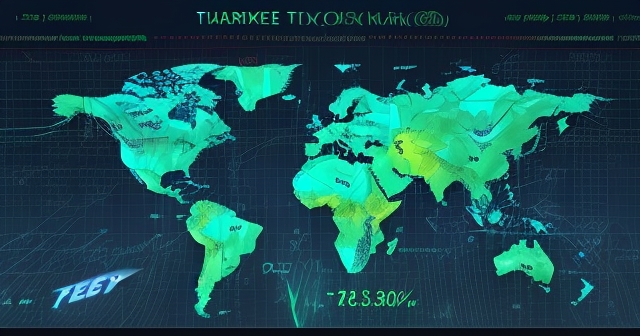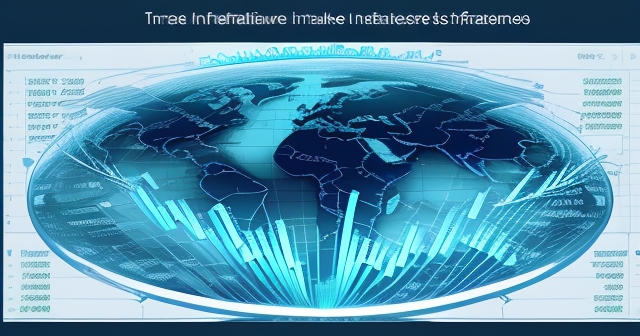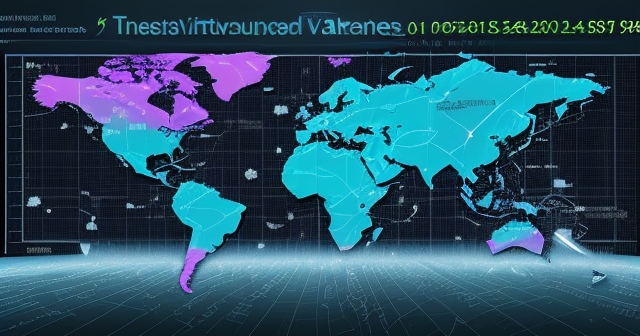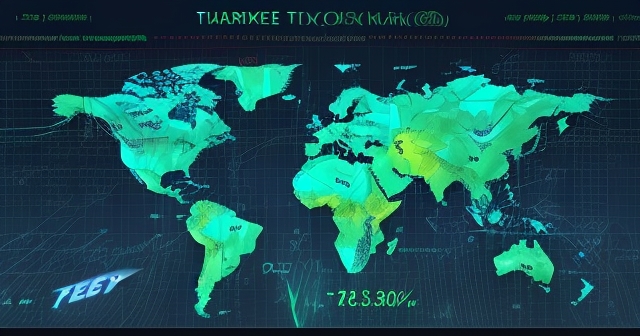Navigating the Tempest: Tariffs, Inflation, and the Shifting Landscape of Trade Quotes
Welcome to our deep dive into the current state of the market. As you’ve likely observed, it’s been a turbulent period. Major indices are under significant pressure, and the conversation around economic stability and future growth is intensifying. For both seasoned traders and those just beginning their journey, understanding the forces at play is absolutely crucial. We’re here to help you cut through the noise and grasp the fundamental drivers behind the recent market movements and the dynamics of trade quotes.
Think of the market as a vast, interconnected ecosystem. Every piece of news, every policy decision, every shift in economic data sends ripples through this system, ultimately influencing the perceived value of assets and, consequently, the trade quotes you see on your screen. Right now, some very powerful forces are creating significant waves.
The challenges faced by traders today include:
- Market volatility, which affects trade quotes.
- Shifts in global economic fundamentals.
- The impact of policy decisions on market dynamics.

The Unmistakable Scale of the Market Selloff
Let’s start by acknowledging the raw numbers because they tell a compelling story. We’ve witnessed a substantial decline across major US stock indices. The Dow Jones Industrial Average, the S&P 500, and the Nasdaq Composite have all registered significant losses. Looking at futures tells a similar, perhaps even more concerning, tale, with Dow, S&P 500, and Nasdaq futures showing notable plunges, suggesting that the pressure isn’t easing in pre-market trading.
Consider the historical context. The S&P 500, often seen as a benchmark for the broader market’s health, is currently on pace for its worst quarter since 2022. Even more strikingly, it has faced its worst three-day stretch since the infamous 1987 crash. These aren’t just minor dips; they represent a significant recalibration of market expectations and risk appetite. Wall Street has certainly been navigating an “ugly stretch,” and many analysts anticipate that conditions could worsen before they improve.
This widespread selling is reflected in the VIX index, often called the market’s “fear gauge.” A rising VIX indicates increased expected volatility, meaning investors anticipate larger price swings in the near future. For you as a trader, this heightened volatility presents both challenges and opportunities. It requires more careful risk management but can also offer quicker potential gains (or losses) if you’re trading instruments like options or actively trading short-term price movements. Understanding how volatility impacts bid-ask spreads and execution priority in trade quotes becomes paramount.
The pervasive atmosphere is one of risk-off sentiment. What does this mean? It means investors are moving away from assets perceived as riskier, such as stocks, and towards safer havens, like government bonds or cash. This collective shift in sentiment directly impacts trade quotes across the board, pushing down the prices of risk assets as demand wanes and selling pressure mounts.

Tariffs: The Political Lever Pulling Market Strings
One of the most frequently cited culprits for the current market carnage is tariffs. Specifically, trade policies, particularly those associated with the previous administration, are identified as a major driver of the selloff. Tariffs are essentially taxes on imported goods. While intended to protect domestic industries, they can have far-reaching consequences for global supply chains, corporate profitability, and international relations.
The data we’re seeing highlights a direct link. There are stark warnings regarding the potential for these trade measures to upend the world’s financial system. This isn’t hyperbole; large-scale disruptions to trade flows can impact everything from corporate revenues to inflation rates and currency valuations. The uncertainty created by the threat or imposition of tariffs makes long-term financial planning and valuation more difficult for companies, leading investors to demand a higher risk premium, which translates to lower stock prices.

The call for a 90-day timeout on tariffs by figures like Bill Ackman underscores the view that these policies are having a destabilizing effect. Such calls reflect a desire for predictability and a pause to assess the damage and potential paths forward. Even statements from political leaders, such as those claiming other countries are seeking tariff deals, are closely watched by the market for any signs of de-escalation or further tension, both of which can immediately influence trade quotes.
| Company | Price Target Cut | Reason |
|---|---|---|
| Tesla | Down | Tariff fallout |
| Apple | Down | Tariff fallout |
The impact isn’t just theoretical; it’s hitting companies directly. We’ve seen price target cuts for major players like Tesla and Apple explicitly attributed to tariff fallout. For a company like Apple, reliant on complex global supply chains involving manufacturing in various countries and selling into markets worldwide, tariffs on components or finished goods can increase costs, reduce margins, and potentially impact demand if price increases are passed on to consumers. For Tesla, tariffs could affect the cost of materials or the ability to sell vehicles profitably in certain markets. These analyst downgrades, based on tariff impacts, directly influence investor perception and contribute to selling pressure on these specific stocks, reflected in their trade quotes.
Beyond specific corporate examples, broader tariff discussions, such as those concerning auto tariffs impacting car prices, further illustrate how trade policy translates into economic reality and, subsequently, market valuations. When the cost of goods increases due to tariffs, it can dampen consumer spending, which in turn affects the revenue and profitability of companies across various sectors, leading to downward pressure on their stock prices and associated trade quotes.
Economic Headwinds: The Double Whammy of Inflation and Slowing Growth
Adding fuel to the fire is a potent mix of inflation fears and concerns about the pace of economic growth. We’ve seen stocks plummet following hot inflation reports. When inflation is high and persistent, it erodes purchasing power, both for consumers and businesses. For companies, rising costs of raw materials, labor, and transportation can squeeze profit margins. For consumers, higher prices for everyday goods leave less disposable income for discretionary spending, potentially impacting corporate revenues.
Furthermore, persistent inflation often prompts central banks, like the Federal Reserve, to tighten monetary policy, typically by raising interest rates. Higher interest rates increase the cost of borrowing for businesses (impacting expansion plans) and consumers (impacting spending on big-ticket items like homes and cars). Higher rates also make safer investments, like bonds, relatively more attractive compared to riskier assets like stocks, as the “risk-free” rate of return increases. This gravitational pull towards lower-risk assets contributes to the “risk-off” sentiment we discussed earlier, leading to lower valuations for equities and influencing trade quotes.
Simultaneously, there are growing worries about a slower economy. Economic indicators, such as manufacturing data, retail sales figures, and employment reports, are closely watched for signs of deceleration. Weak consumer data, for instance, cited as a factor for tumbling shares, suggests that the engine of consumer spending, a major driver of the US economy, might be sputtering. When the market anticipates slower economic growth, it expects lower future corporate earnings, justifying lower stock prices today.

The specter of a potential recession looms over the market. While not universally predicted, discussions about recession potential are frequent. The earnings reports of big banks are often seen as bellwethers for the economy’s health. Their lending activity, consumer credit trends, and investment banking performance can provide valuable insights into the broader economic landscape. Watching these indicators is crucial for assessing the likelihood and potential severity of an economic downturn, which would have profound implications for market valuations and trade quotes.
Additionally, there’s discussion about pressure on “Dollar dominance” and its implications for the US. While perhaps less immediate than tariffs or inflation, shifts in global currency dynamics can impact trade competitiveness, the cost of imports/exports, and the flow of international capital, all of which can indirectly influence the health of US companies and the attractiveness of US assets to foreign investors, ultimately affecting stock prices and trade quotes.
Navigating Volatility: The VIX and Market Dynamics
Let’s talk more about volatility. The surge in the VIX index is a critical signal. It doesn’t predict direction (whether the market will go up or down), but it measures the market’s expectation of future volatility, typically over the next 30 days, based on S&P 500 index options. A higher VIX means options prices are higher, reflecting increased demand for protection against large price swings or speculation on future volatility.
For you as a trader, increased volatility means that price movements can be much larger and happen more quickly. A stock that typically moves 1-2% in a day might suddenly move 3-5% or more. This environment requires a different approach:
Wider swings lead to:
| Strategy | Explanation |
|---|---|
| Wider Swings | Be prepared for larger fluctuations in your portfolio value. |
| Risk Management | Position sizing becomes even more critical. You might need to reduce the size of your trades to manage the larger potential dollar swings against you. |
| Stop-Loss Orders | These become indispensable tools to limit potential losses if a trade moves sharply against you. |
| Execution | In highly volatile markets, the spread between the bid and ask price can widen, impacting your effective entry and exit points on trade quotes. |
| Opportunity | For those with strategies designed for volatility, this environment can present opportunities for larger gains, though with higher risk. |
Understanding volatility isn’t just about acknowledging risk; it’s about incorporating it into your trading plan. How does the VIX level influence your strategy? Does it make you favor certain asset classes or instruments over others? These are questions every trader must ask themselves in the current climate.
This period of heightened volatility also shines a light on market structure changes. The increase in off-exchange trading volume, for example, noted as a significant shift, can impact price discovery and liquidity on traditional exchanges. While this might be a more advanced concept, understanding that trade quotes aren’t solely determined on a single public order book highlights the complexity of modern market mechanics.
Beyond the Indices: Sector and Asset Specifics in the Selloff
While major indices capture the headlines, the selloff doesn’t affect all assets and sectors equally. Looking closer reveals nuances that are crucial for making informed trading decisions.
The so-called Magnificent 7, the group of mega-cap tech stocks that have often led the market, have experienced significant drops. These companies (Apple, Microsoft, Alphabet, Amazon, Nvidia, Meta, Tesla) are highly sensitive to economic growth expectations and interest rate changes. When growth slows and borrowing costs rise, their often-high valuations come under pressure, contributing significantly to the overall market decline given their large weighting in indices like the S&P 500 and Nasdaq.
We’ve already mentioned Apple and Tesla’s price target cuts due to tariffs, but their drops are also part of the broader tech sector weakness. The interconnectedness of global supply chains and international markets means these giants are particularly exposed to trade tensions and shifts in the global economy.
Beyond equities, other asset classes are also feeling the pinch. Bitcoin falling amid the global market swoon demonstrates that cryptocurrencies, often seen as uncorrelated or even a hedge against traditional finance, are still susceptible to broad risk-off sentiment. When investors panic, they tend to sell across the board, including digital assets, reinforcing the idea that Bitcoin, while revolutionary, is not immune to macroeconomic forces.
Market sentiment is also reflected in new market entrants. The muted Nasdaq debut for CoreWeave, a cloud computing company, reflects skepticism in the current environment. A healthy IPO market typically signifies investor optimism and a willingness to embrace growth stories. A lukewarm reception suggests caution and a higher bar for new companies seeking public funding.
However, not everything is declining. Analyst recommendations, such as seeing Dollar General as a buy due to consumers trading down, highlight potential defensive plays. In an environment where consumers face inflationary pressures and economic uncertainty, they tend to cut back on discretionary spending and focus on value. Companies that cater to budget-conscious consumers may perform relatively better, offering potential safe havens within a challenging market.
Similarly, in fixed income, the expectation that short-term Treasuries are expected to rise reflects the move towards safety. As investors seek lower-risk assets, demand for government debt increases, pushing bond prices up and yields down for existing bonds, or in the case of rising interest rates, leading to higher yields on newly issued short-term debt as the Fed tightens policy. Understanding the relationship between interest rates, bond prices, and the equity market is vital for a complete picture of the current landscape affecting various trade quotes.
It’s worth noting that even amidst the selloff, individual corporate achievements stand out, like Apple becoming the most valuable US public company at one point. Such milestones, while impressive, need to be viewed within the broader context of market sentiment and macroeconomic headwinds. Even the largest and most successful companies are not immune to systemic risks.
Policy and Geopolitical Risks: A Wider Lens on Market Movers
While our focus is primarily on tariffs and inflation originating from the US, it’s important to recognize that markets are global and interconnected. Policy actions and geopolitical events outside the immediate scope of US trade and inflation figures also contribute to the overall uncertainty and can trigger specific reactions in asset prices and trade quotes worldwide.
For instance, US sanctions on Russia forcing an end to Dollar and Euro trading on Russia’s main exchange are a clear example of how policy can drastically impact currency markets and international finance. Such actions create ripple effects, altering trade flows, impacting foreign exchange rates, and potentially influencing the strategies of multinational corporations.
Similarly, political developments abroad, such as French election fears causing markets to fear a financial crisis in France, demonstrate the sensitivity of global markets to political stability. Uncertainty about leadership or policy direction in a major economy can lead to capital flight, currency depreciation, and declines in local equity markets, with potential spillover effects into other regions.
These examples illustrate that for a comprehensive understanding of market dynamics and the factors influencing trade quotes, you need to cast a wide net. While US domestic issues like tariffs and inflation are currently dominant drivers, staying aware of significant international policy shifts and geopolitical tensions is essential for navigating the global investment landscape. How might events in Europe or Asia impact companies in your portfolio? How do currency movements affect the profitability of international businesses? These are questions that connect global events to the trade quotes you observe daily.
For the Investor: Understanding and Utilizing Trade Quotes in Turmoil
In this volatile environment, understanding how to interpret and utilize trade quotes becomes even more critical. A trade quote isn’t just a number; it’s a snapshot of the market’s consensus value for an asset at a specific moment in time. It represents the point where buyers and sellers are currently meeting.
Every trade quote includes key pieces of information:
- Last Price: The price at which the most recent trade occurred.
- Bid Price: The highest price a buyer is currently willing to pay.
- Ask (or Offer) Price: The lowest price a seller is currently willing to accept.
- Volume: The number of shares or contracts traded.
- Change: The difference between the current price and the previous day’s closing price.
- % Change: The percentage change from the previous day’s closing price.
- Bid Size / Ask Size: The number of shares or contracts buyers and sellers are willing to trade at the bid and ask prices.

In times of high volatility, the spread between the bid and ask prices can widen. This is because market makers (entities that facilitate trading) face greater risk holding inventory when prices are moving sharply. A wider spread means that the cost of executing a trade (the difference between the price you buy at and the price you could immediately sell at) increases. This is a hidden cost of volatility that directly impacts your profitability, especially for frequent or large trades.
High volume often confirms the strength of a price move. If a stock is falling sharply on high volume, it suggests strong selling pressure rather than just a few participants. Conversely, a small price move on high volume might indicate consolidation or indecision.
Observing the change and % change throughout the day gives you a real-time sense of the asset’s performance relative to its previous close. Tracking these figures across different assets and indices helps you identify where the strongest selling (or occasional buying) pressure is concentrated.
For beginner investors, seeing significant negative changes in your portfolio can be unnerving. It’s important to remember that short-term price swings are normal, especially in volatile periods. Focus on understanding *why* prices are moving – the underlying forces of tariffs, inflation, and economic outlook we’ve discussed – rather than getting caught up in every tick of the quote. For those interested in technical analysis, these volatile price movements create patterns that can be studied using charts and indicators, potentially offering insights into short-term direction, though technical analysis is also more challenging in highly unpredictable environments.
Accessing reliable, real-time trade quotes is foundational to any trading activity. Whether you are focusing on stocks, futures, or exploring other instruments like CFDs (Contracts For Difference) which derive their value from underlying assets, the platform you use to view these quotes and execute trades is a critical component of your trading infrastructure.
If you’re considering starting your trading journey, particularly exploring various financial instruments or focusing on global markets, selecting a robust trading platform is key. Factors to consider include the range of instruments offered, the speed of trade execution, the available trading platforms (like MT4, MT5), and the regulatory environment of the broker. This is where the practical side of connecting market analysis to actual trading takes place.
Choosing the right trading platform involves evaluating its reliability, the variety of assets it offers, and its regulatory compliance. A platform that provides access to global markets, offers various trading instruments, and is regulated by reputable authorities can provide a secure base for your trading activities. The flexibility to use popular trading platforms like MT4 or MT5, combined with competitive trading conditions such as low spreads and high execution speed, are factors professional traders often prioritize.
What’s Next? Watching Earnings and Economic Data
In this environment, future trade quotes will be heavily influenced by upcoming data and events. What should you be watching?
- Inflation Reports: Subsequent releases of the Consumer Price Index (CPI) and Producer Price Index (PPI) will be crucial indicators of whether inflationary pressures are easing or persisting.
- Federal Reserve Commentary: Statements and speeches from Fed officials will provide clues about their stance on inflation and interest rates. Will they signal a pause, further hikes, or even potential cuts?
- Economic Growth Data: GDP reports, retail sales data, manufacturing indices (like the ISM Manufacturing PMI), and employment figures will offer insights into the health and momentum of the economy.
- Corporate Earnings: As companies report their quarterly results, pay close attention not just to whether they beat or miss estimates, but to their forward guidance. What are they saying about future revenue, profit margins, and the impact of tariffs and inflation on their business?
- Trade Policy Developments: Any news regarding potential changes to existing tariffs or the imposition of new ones will immediately grab market attention.
- Geopolitical Events: Keep an eye on major political developments in key global regions and any escalation or de-escalation of international tensions.
Each of these data points and events has the potential to shift market sentiment, alter expectations about future earnings or interest rates, and directly impact trade quotes. Understanding the market’s focus on these indicators is essential for anticipating potential price movements.
The Long-Term Perspective vs. Short-Term Swings
For many long-term investors, market selloffs can be unsettling, but they are also a normal part of the market cycle. While the current confluence of tariffs, inflation, and economic fears is potent, it’s important to differentiate between short-term volatility and long-term investment goals. Market downturns can present opportunities for those with a long-term perspective to acquire quality assets at lower prices, a concept often associated with value investing.
However, for active traders focused on shorter time horizons, the current environment demands heightened awareness and adaptability. Strategies that worked in a low-volatility, low-inflation environment may not be effective now. Technical analysis patterns can be less reliable amidst sharp, news-driven swings. It requires discipline, robust risk management, and a deep understanding of how macroeconomic and policy factors translate into price movements and affect the reliability of trade quotes.
We’ve covered a lot of ground, from the scale of the selloff and the specific culprits like tariffs and inflation to the nuances of volatility and sector-specific reactions. The market is a complex system, and understanding the interplay of these factors is key to navigating it successfully, whether you’re building a retirement portfolio or actively trading daily swings.
Remember, knowledge is your most powerful tool in the markets. By continuously learning and adapting to the changing landscape, you position yourself to make more informed decisions, manage risk effectively, and pursue your financial goals, even in the face of significant headwinds. Keep analyzing the data, understanding the drivers behind the trade quotes, and refining your approach. We are here to guide you on this journey.
trade quotesFAQ
Q:What are trade quotes?
A:Trade quotes provide the latest price information for assets, reflecting the current market pricing and demand.
Q:How do tariffs impact trade quotes?
A:Tariffs can raise costs for companies, reducing their profitability and driving down stock prices, which in turn affects trade quotes.
Q:What role does inflation play in market dynamics?
A:Inflation erodes purchasing power, influences interest rates, and can cause investors to shift from riskier assets, impacting market valuations and trade quotes.
